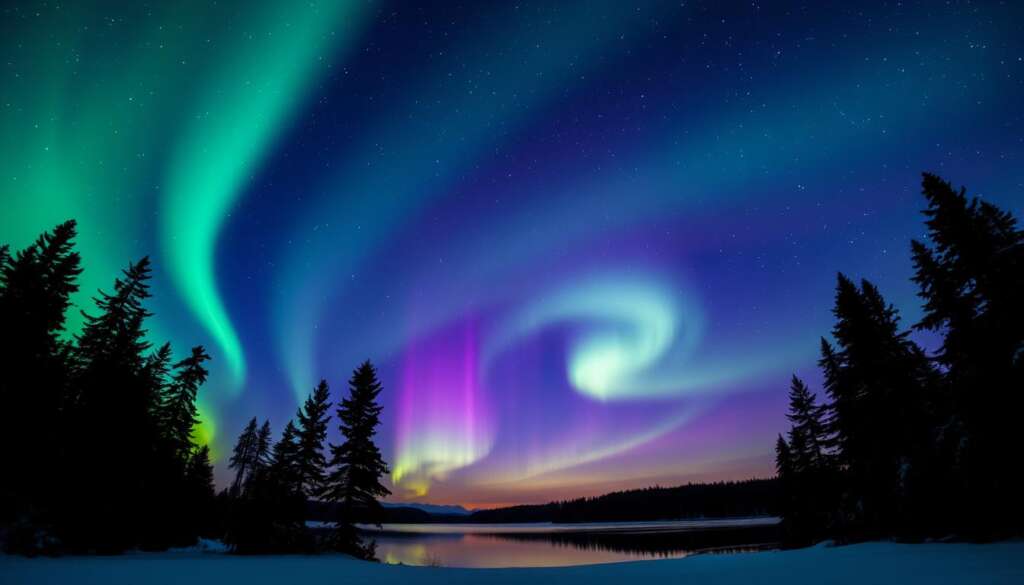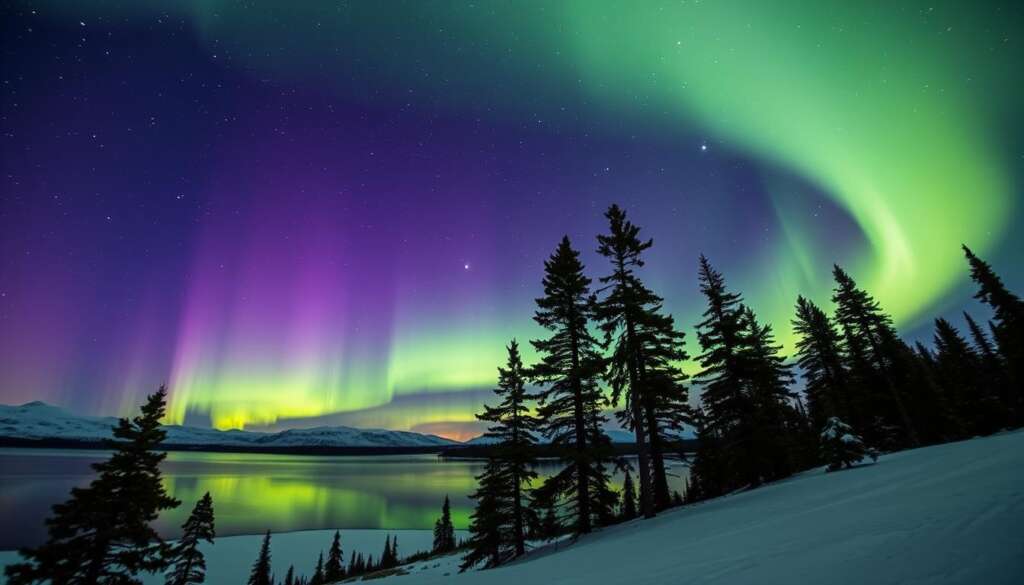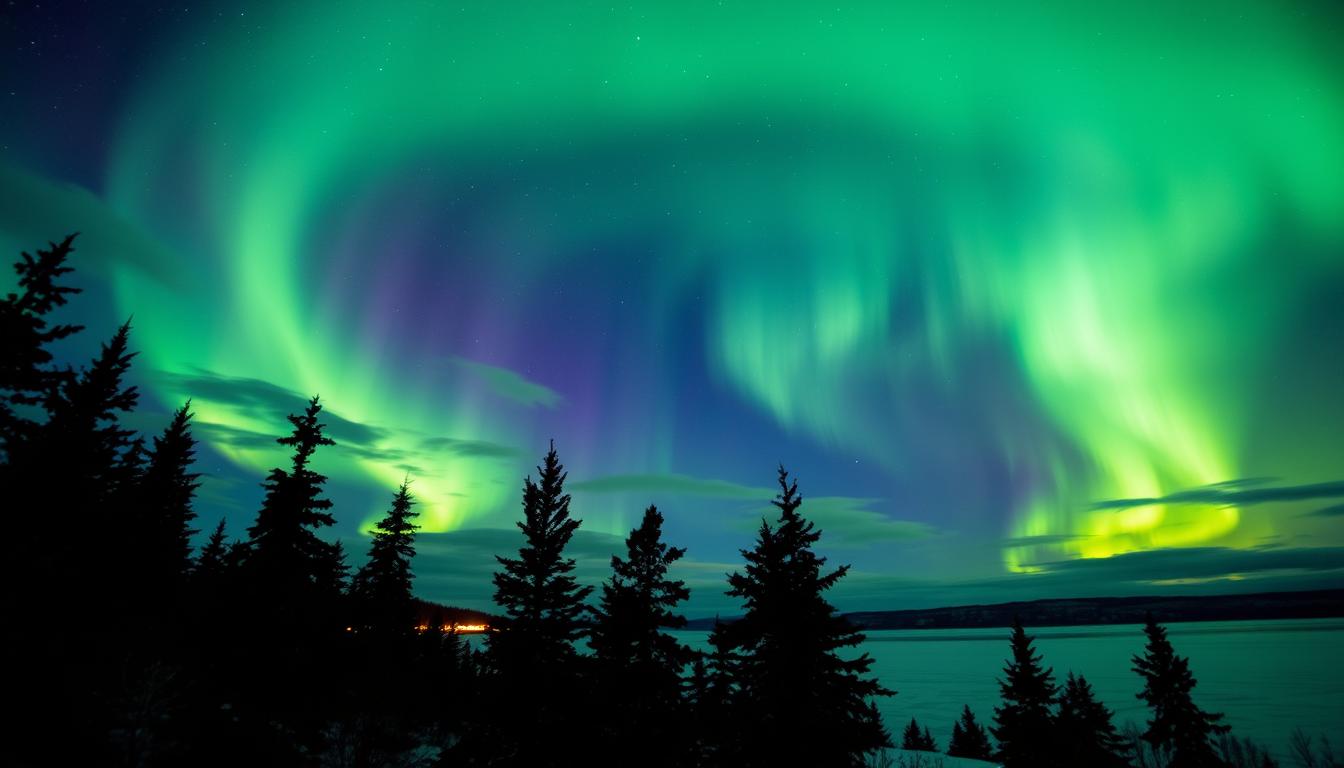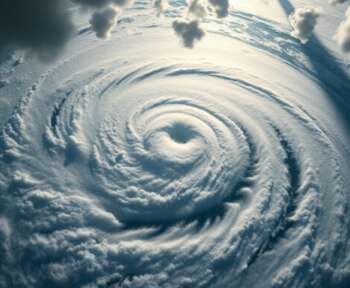As a resident of the United States, I’m excited to share that the northern lights are expected to dazzle tonight. A severe geomagnetic storm detected by NOAA will bring vibrant purple, red, and green hues across the northern half of the country. This could even reach as far south as Alabama and northern California.
The storm, a G4 geomagnetic event, is caused by increased solar activity. It’s moving towards Earth at over 2.5 million miles per hour. Forecasters believe the best viewing times will be throughout the night, especially in areas with less light pollution.
Even if the auroras seem faint, you can still capture them with your smartphone. Use night mode to increase exposure time. So, whether you love stargazing or just want to see the night sky’s wonders, go outside and enjoy this amazing event.
Key Takeaways
- A severe G4 geomagnetic storm is expected to bring the northern lights further south tonight, potentially visible across the northern half of the U.S.
- The best viewing opportunities will be in areas away from city lights, with the potential for the auroras to reach as far south as Alabama and northern California.
- Smartphone cameras can capture the shimmering light show by using night mode to increase exposure time.
- More geomagnetic storms and auroras are expected through 2025 as the Sun nears peak activity in its 11-year cycle.
- The storm can potentially impact critical infrastructure, but NOAA advises the public can still safely enjoy the celestial spectacle.
What Causes the Northern Lights?
The northern lights, or aurora borealis, are a stunning sight. They happen when the sun’s energy meets the Earth’s magnetic field. Solar storms send high-energy particles towards us. These particles excite atoms in our atmosphere, creating the colorful lights we see.
Solar Storms and Geomagnetic Activity
The northern lights’ beauty depends on the solar storm’s size and speed. The Earth’s magnetic field also plays a role. As the solar cycle peaks, we can expect more intense displays of the aurora borealis.
Interaction of Solar Particles with Earth’s Atmosphere
Solar particles hit the Earth’s magnetic field and are drawn to the poles. There, they collide with the upper atmosphere. This collision excites the atoms, causing them to glow in the colors we see in the northern lights.
| Statistic | Value |
|---|---|
| Kp-index readings of six plus (6+) | Indicate the potential to see the northern lights, with no set schedule for aurora occurrences. |
| Expected solar minimum | 2019–2020, with solar maximums resulting in greater frequency of aurora, possibly making the years 2022–2027 the best for sightings. |
| Best months for viewing the northern lights | August through April, with October, November, and April being peak months. |
The northern lights show us nature’s power and beauty. They remind us of the sun’s energy and our planet’s magnetic field. Understanding these forces helps us appreciate the wonder of space weather.
Where to See the Northern Lights Tonight
If you want to see the northern lights tonight, go to places with dark skies and little light pollution. The National Oceanic and Atmospheric Administration says there will be a KP index of four tonight. This means the northern lights might be seen as far south as Nebraska’s southern edge.
Top spots for viewing the northern lights include Alaska and parts of Washington, Idaho, Montana, North Dakota, Minnesota, Michigan, and Wisconsin. Other places with a good chance of seeing the lights tonight are Colorado, Connecticut, Illinois, Indiana, Iowa, Maine, Massachusetts, Missouri, Nebraska, New Hampshire, New Jersey, and New York. The best time to see the aurora is between 10 p.m. and 2 a.m. when skies are clear and light pollution is low.
- Alaska
- Northern Washington
- Northern Idaho
- Northern Montana
- North Dakota
- Northern Minnesota
- Northern Michigan
- Northern Wisconsin
- Colorado
- Connecticut
- Illinois
- Indiana
- Iowa
- Maine
- Massachusetts
- Missouri
- Nebraska
- New Hampshire
- New Jersey
- New York
To see the northern lights best, get away from cities and find a spot with a clear view of the northern sky. Use low shutter speeds and night mode on your smartphone to capture the aurora borealis.
“The aurora may be visible in many northern states and some areas of the lower Midwest to Oregon over the upcoming nights.”
Best Viewing Locations in the Northern Latitudes
The strength of the solar storm will decide how far south the northern lights can be seen. This storm is not as strong as some others, but it still promises bright displays of the aurora borealis. With clear skies forecasted, Thursday night is a great time to see this amazing celestial show.
The moon is in its first quarter phase, so there won’t be much moonlight to block the view. However, the chances to see the aurora will get lower by Friday night. You might need to go further north or even to Canada to see it then.
Northern Lights Tonight: Regional Visibility Forecast
The northern lights will be a big show tonight, but how well you can see them depends on the weather. In the San Francisco Bay Area, skies will be partly cloudy, which might block the view in some spots. But, inland areas are expected to have clearer skies, making it easier to see the aurora borealis.
The northern lights might be seen as far south as the lower Midwest and Northern California. But, where and when you can see them best is still a mystery. It’s important to keep an eye on weather reports and space weather updates to find the best spots and times to watch the auroras.
| Location | Sky Conditions | Visibility Forecast |
|---|---|---|
| San Francisco Bay Area | Partly Cloudy | Moderate |
| Inland California | Clear | High |
| Lower Midwest | Variable | Moderate to High |
Clouds and weather patterns are key to seeing the northern lights tonight. It’s important to stay updated with the northern lights forecast, aurora borealis visibility, and regional sky conditions. This will help you enjoy this amazing celestial event.
“The best time to see the northern lights is typically between 10 p.m. and 2 a.m. local time, when the sky is at its darkest.”
With clear skies and good weather, the northern states might see an incredible aurora borealis show tonight. Photographers and nature lovers will be amazed by the colors and movements of this natural wonder.
Capturing Stunning Aurora Photos
Even when the northern lights are hard to see, smartphones can still take amazing photos. To capture the auroras, use your camera’s night mode or long exposure settings. These options let the camera take in more light, showing off the northern lights‘ colors.
Make sure your camera is steady to avoid blurry photos. Try different angles and shots to make the northern lights look even more amazing. On iPhone, night mode kicks in when it’s dark, shown by a yellow icon. Samsung Galaxy phones have a yellow moon icon for night mode too.
Tips for Photographing the Northern Lights
- Use your smartphone’s night mode or long exposure settings to capture more light and reveal the auroras.
- Stabilize your camera with a tripod or mount to avoid blurry images.
- Experiment with different compositions and framing to showcase the northern lights in the most visually stunning way.
- Get away from city lights to minimize light pollution and improve visibility of the aurora borealis.
- Dress warmly, as temperatures during the aurora event can range in the 30s and 40s Fahrenheit.
By following these tips, you can capture the mesmerizing display of the northern lights and create breathtaking aurora photography with your smartphone camera.
“The northern lights are one of nature’s most awe-inspiring displays, and with the right camera techniques, you can immortalize their beauty in stunning photographs.”
The Science Behind Space Weather Prediction
The National Oceanic and Atmospheric Administration (NOAA) and its Space Weather Prediction Center have made huge strides in space weather forecasting. They watch the sun closely, tracking events like coronal mass ejections (CMEs) that affect Earth’s magnetic field.
Thanks to satellites and ground-based observatories, scientists can now predict when and where to see the northern lights. This helps skywatchers plan their viewing, so they don’t miss the amazing display.
| Solar Cycle Statistics | Geomagnetic Storm Levels |
|---|---|
|
|
The Kp index shows how far south the aurora can be seen. For each increase in Kp, the aurora moves about 2 degrees closer to the equator. The North Magnetic Pole, in northeast Canada, is key to these displays.
The NOAA Space Weather Prediction Center tracks the sun’s activity and geomagnetic storms. They provide forecasts that help skywatchers in the United States plan their northern lights viewing.
northern lights tonight: A Celestial Spectacle
Tonight, people across the United States will see the northern lights, or aurora borealis. This amazing sight happens when the sun’s activity meets the Earth’s magnetic field. A severe geomagnetic storm is forecast, making this natural wonder visible to more people.
Recently, every U.S. state except Hawaii saw the aurora borealis on Thursday, October 11, to Friday, October 12. It was also seen in Europe, including Turkey, and in China. This shows how far-reaching this celestial phenomenon is.
A fast-moving coronal mass ejection from the sun on October 8 caused this display. It moved at 2.5 million miles per hour, the fastest in our solar cycle. The sun’s approach to a “solar maximum” has led to more intense storms, making the vibrant northern lights last until 2026.
Seeing the aurora borealis tonight is a mesmerizing experience. It reminds us of the dynamic processes that shape our night sky viewing and the natural wonders of our universe. Whether you love stargazing or just enjoy the beauty of the northern lights display, this is a spectacle you shouldn’t miss.

The best time to see the aurora borealis is between 9 PM and 2 AM. The northern lights might be seen as far south as Alabama and northern California if the sky is clear. Places like North Dakota, Montana, Minnesota, Washington, Idaho, and Wisconsin are expected to have a vibrant aurora borealis show.
“The shimmering ribbons of color that dance across the night sky are a reminder of the dynamic processes that shape our universe.”
Impact of Solar Storms on Communication Networks
The stunning northern lights are a sight to behold, but they come with a warning. A severe geomagnetic storm is heading towards Earth. It threatens our communication networks and power infrastructure.
Strong solar storms can cause damaging currents in power grids. This leads to voltage fluctuations and blackouts. They can also mess with radio signals used by emergency responders. This could make it hard for them to work together, especially in areas hit by recent disasters.
Potential Disruptions to Power Grids and Radio Signals
Experts at the NOAA’s Space Weather Prediction Center are watching closely. They’re working hard to lessen the storm’s effects. This week’s solar storm is a level 4 out of 5 on the geomagnetic storm scale.
It could even reach a rare level 5. Such storms can cause currents in power grids. This can lead to voltage changes and blackouts. They can also mess with radio signals, making it tough for emergency teams to communicate.
| Impact on Power Grids | Impact on Communication Networks |
|---|---|
|
|
The NOAA and other agencies are working hard to protect our systems. They aim to lessen the storm’s impact on our communication and energy systems. The next few days will show us how much the solar storm impact and space weather disruptions affect power grid vulnerabilities and radio signal interference.
Best Places to Witness the Auroras
For the best northern lights view, look for places with clear skies and little light pollution. Alaska, northern Minnesota, and upstate New York are top spots in the U.S. They offer great views because of their remote locations and dark skies.
Outside the U.S., Iceland, northern Scandinavia, and Canada’s Yukon Territory are also great for seeing the auroras. These areas have long, dark nights and little light pollution. They’re perfect for watching the northern lights.
To see the northern lights, find a spot with a clear view of the northern horizon. Stay up late to catch the show. With good planning and luck, you can see the northern lights in these remote spots.
“Every traveler sent to Alta, Norway, for at least three nights in the past 20 years has seen the northern lights.”
The northern lights are visible all year but are most seen in winter. In Alta, Norway, the best time is from late August to early March. In Iceland, the best months are October to March.
- In northern Canada, the best time is from late January to early March. November and December also have clear skies.
- Recommended activities at the northern lights viewing locations include ice fishing, dog sledding, and snowmobiling.
- In Norway, Reine and Alta are great places to see the northern lights. They offer unique experiences under the auroral oval.

To have a great northern lights adventure, be ready to stay up late. Embrace the surprise of this natural wonder. With the right planning and luck, you can see the amazing aurora borealis hotspots.
Conclusion
The northern lights tonight are captivating skywatchers across the United States. These celestial wonders inspire and fascinate us. The sun’s activity and Earth’s magnetic field create a stunning display of nature’s power.
This display is visible as far south as the Midwest and Northern California. The timing and extent of the auroras are uncertain. Yet, the chance to see this natural wonder shows our ongoing scientific exploration.
Whether through a camera or the naked eye, the northern lights tonight remind us of our planet’s connection to the universe. They show the dynamic processes that shape our world. They also remind us of the natural wonders that captivate and inspire us.
Looking ahead to Solar Cycle 25, we expect more northern lights. This means more chances for skygazers to see this amazing spectacle. By staying informed and venturing to dark places, we can experience the magic of the aurora borealis.



